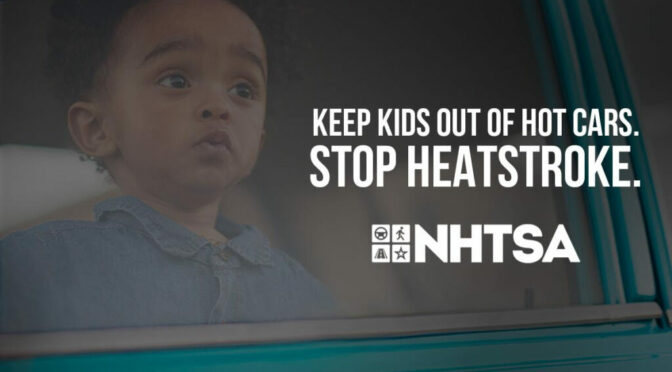| I’ll just run in for a minute.”
“I thought you were picking her up.”
“I only let him play outside for a minute.”
The U.S. Department of Transportation’s National Highway Traffic Safety Administration and other safety advocates recognize the safety threat heatstroke poses for children left unattended in hot cars.
Heatstroke is the leading cause of non-traffic, non-crash-related fatalities for children 14 and younger:
· In 2020, 24 children died due to vehicular heatstroke. In 2019, 53 children died in vehicular heatstroke incidents. The significantly lower number of deaths in 2020 is likely due to more families being at home.
· From 1998-2020, a total of 882 children died due to vehicular heatstroke.
Of the 882 deaths:
· 52.9%: Forgotten by caregiver (467 children)
· 25.6%: Gained access on their own (227)
· 19.7%: Knowingly left by caregiver (173)
· 1.7 %: Unknown (15)
How this happens:
Most of these tragedies happen when a child is forgotten by a parent or caregiver and left in a hot car. In approximately half of these “forgotten” deaths, the child was being taken to childcare/preschool. A busy parent or caregiver may unintentionally forget that a quiet or sleeping child, one who may also be facing the back of the car, is in the back of the vehicle. This generally occurs with children under one year of age. Always remember to look before you lock. You could save a life.
Toddlers or mobile young children are also at risk.
Some children gain access into a vehicle without the knowledge of an adult and may be unable to get out of the car, especially if child locks are activated. It is essential to teach children that it is dangerous to play in or around the car.
Sometimes, children are left intentionally by parents who do not understand the dangers of a hot vehicle, or who may not understand how quickly a vehicle can heat up to dangerous temperatures. It cannot be overstated: Never leave your child in a vehicle alone, not even for a minute.
High body temperature can cause permanent injury or even death:
Heatstroke begins when the core body temperature reaches approximately 104 degrees and the thermoregulatory system is overwhelmed. A core temperature of approximately 107 degrees is lethal.
Children are at a higher risk than adults of dying from heatstroke in a hot vehicle, especially when they are too young to alert others for help. A child’s body temperature rises three to five times faster than an adult’s.
In 10 minutes, a car can heat up by 20 degrees. Rolling down a window does little to keep a vehicle cool. Heatstroke fatalities have occurred even in vehicles parked in shaded areas and when the outside air temperatures were 80 degrees Fahrenheit or less.
Summertime is the peak season for these tragic incidents, but heatstroke can occur in outdoor temperatures as low as 57 degrees. |
